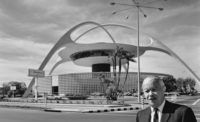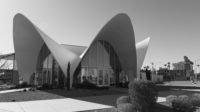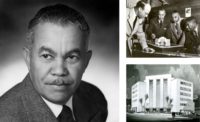USC Architecture and Getty Research Institute Acquire Archive of Paul Revere Williams

Paul Revere Williams (pictured in 1952) designed a house (completed in 1955) or for Lucille Ball and Desi Arnaz in Palm Springs, California.
Photo by Julius Shulman, © J. Paul Getty Trust
The University of Southern California (USC) School of Architecture and the Getty Research Institute (GRI) have together acquired the archive of late Black American architect Paul Revere Williams, who died in 1980 at age 85. The collection—which has been maintained by his granddaughter Karen Elyse Hudson and will be housed at the Getty—includes some 35,000 plans and 10,000 original drawings of both built and unbuilt work, as well as blueprints, project diazotypes, hand-colored renderings, vintage photographs, and correspondence

Williams operated extensively in Los Angeles and Southern California for nearly six decades, completing more than 3,000 projects in the U.S. and abroad. A master of the Late Moderne style, single-family residences were a major focus for the architect, who designed homes for Hollywood stars, business leaders, and middle-class citizens alike. Some of his A-Lister clients included Lucille Ball and Desi Arnaz, Bill “Bojangles” Robinson, Frank Sinatra, and Cary Grant.
Later in his career, Williams’ work included commercial, institutional, and public buildings. In Los Angeles, some of his most notable projects are the headquarters of Music Corporation of America in Beverly Hills, the Crescent Wing of the Beverly Hills Hotel, the interiors of Saks Fifth Avenue at 9600 Wilshire Boulevard, and the Golden State Mutual Life Insurance Building. He designed the Hotel Nutibara in Medellín, Colombia, and served as associate architect for the U.N. Building in Paris and Langston Terrace in Washington, D.C.—the first federally sponsored public housing in the country.

“The work contained in this archive tells many stories,” said Milton S. F. Curry, dean of the USC School of Architecture. “It contains the creative expressions of an architect working across many different constituencies in a socially complicated time. It also contains evidence of stunning aesthetic innovations that reimagined the space and program of public housing, hotels, and residential design and civic space.”
Williams became the first Black architect to join the American Institute of Architects (1923) and to become a member of its College of Fellows (1957). In 2017, the organization posthumously awarded him the Gold Medal, making Williams the first Black architect to receive the AIA’s highest honor.

But despite his success, he still endured the hardships of being a Black professional working in largely white spheres, where racism openly touched every aspect of life. He was known for his ability to draw upside down—a skill developed so that his predominantly white clientele could sit across the table from him, at a distance.
“During a period of de jure segregation, Paul R. Williams mastered architecture, a public art form, and was as prolific as he was persistent,” said LeRonn P. Brooks, associate curator for modern and contemporary collections at the GRI. “His legacy is therefore as much about the character of the man himself as it is the scale, variety, and ambitions within a professional practice wed to realizations of perpetual excellence.”
Much of Williams’ archive was thought to have been destroyed in a fire in 1992, during the period of civil unrest in Los Angeles that followed the police beating of Rodney King. But according to USC and GRI, it was primarily business records that were lost.

The collection will become a cornerstone of the Getty’s African American Art History Initiative, which launched in 2018. “This rich, comprehensive archive is one of the most significant acquisitions of 20th-century architecture that Getty has worked on,” said Maristella Casciato, senior curator of architecture at GRI. “The Los Angeles cityscape is a testament to Paul R. Williams’ lasting impact on Southern California and modern architecture in general.”
“Our goal is to continue advancing the incredible legacy of Paul R. Williams, a true trailblazer in the field of architecture, and to share the archive with new and diverse audiences through publications, symposia, exhibitions, and more,” explained Curry. In the coming years, the archive will be digitized and made accessible to scholars and others.



